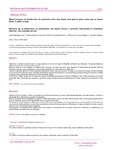Mostrar o rexistro simple do ítem
Effectiveness of diathermy in patients with low back and pelvic pain referred to lower limb: a pilot study
| dc.contributor.author | Rodríguez Sanz, David | |
| dc.contributor.author | Martínez Pascual, Beatriz | |
| dc.contributor.author | Fernández Martínez, Silvia | |
| dc.contributor.author | Cueva Reguera, Mónica de la | |
| dc.contributor.author | Díaz Vega, Ignacio | |
| dc.contributor.author | Calvo-Lobo, César | |
| dc.date.accessioned | 2019-02-21T13:27:43Z | |
| dc.date.available | 2019-02-21T13:27:43Z | |
| dc.date.issued | 2017 | |
| dc.identifier.citation | European Journal of Podiatry, 2017, 3 (2): 41-45 ISSN: 2445-1835 | es_ES |
| dc.identifier.issn | 2445-1835 | |
| dc.identifier.uri | http://hdl.handle.net/2183/21913 | |
| dc.description.abstract | [Abstract] Objectives: Low Back and pelvic pain is a major problem and a common cause of disability and health care utilization. To evaluate diathermy efficacy for low back and pelvic pain treatment. Methods: Reports of 20 multifidus in subjects with a previous low back and pelvic pain diagnosis. A randomized trial blinded with two randomized groups, group A diathermy, group B sham diathermy to check efficacy of diathermy. Results: Diathermy group don´t show significate differences versus sham group due to be apply as an isolated technique but this technique rarely is reported in this way and is frequently associated to perturbational training or a kinesiotherapy program during his activation. A better correlation was achieved by diathermy in Tensomiography values. Conslusions: Further studies are necessary to improve knowledge about physical effects of diathermy due to this technique is frequently associated with a kinesiotherapy program to get better results in patients with prevalent illness as lumbar and pelvic pain referred to lower limb. | es_ES |
| dc.description.abstract | [Resumen] Objetivos: El dolor lumbar y pelvico son problemas de salud prevalentes y la mayor causa de discapacidad y de gasto sanitario. Evaluar la efectividad de la diatermia para el dolor lumbopelvico. Metodo: Se seleccionan 20 multifidus en sujetos con dolor lumbopelvico previo. Se desarrolla un estudio ciego con dos grupos aleatorizados, grupo A diatermia, grupo B diatermia placebo para comprobar la eficacia. Resultados: El grupo tratado con diatermia no mostro diferencias significativas con el grupo placebo de manera aislada. Esta técnica rara vez se usa de manera aislada y se asocia frecuentemente a técnicas de propiocepcion o a fisioterapia. El grupo de diatermia mostro mejores valores en las correlaciones tensomiograficas. Conclusiones: Se necesitan más estudios para incrementar el conocimiento de los efectos físicos de la diatermia en poblaciones con enfermedades prevalente como la lumbalgia | es_ES |
| dc.language.iso | eng | es_ES |
| dc.publisher | Universidade da Coruña | es_ES |
| dc.relation.uri | http://dx.doi.org/10.17979/ejpod.2017.3.2.1947 | es_ES |
| dc.subject | Low back pain | es_ES |
| dc.subject | Pelvic pain | es_ES |
| dc.subject | Diathermy | es_ES |
| dc.subject | Dolor lumbar | es_ES |
| dc.subject | Dolor pélvico | es_ES |
| dc.subject | Diatermia | es_ES |
| dc.title | Effectiveness of diathermy in patients with low back and pelvic pain referred to lower limb: a pilot study | es_ES |
| dc.title.alternative | Eficacia de la diatermia en pacientes con dolor lumar y pélvico refererido al miembro inferior: un estudio piloto | es_ES |
| dc.type | info:eu-repo/semantics/article | es_ES |
| dc.rights.access | info:eu-repo/semantics/openAccess | es_ES |
| UDC.journalTitle | EJPOD: European Journal of Podiatry = Revista europea de podología | es_ES |
| UDC.volume | 3 | es_ES |
| UDC.issue | 2 | es_ES |
| UDC.startPage | 41 | es_ES |
| UDC.endPage | 45 | es_ES |






